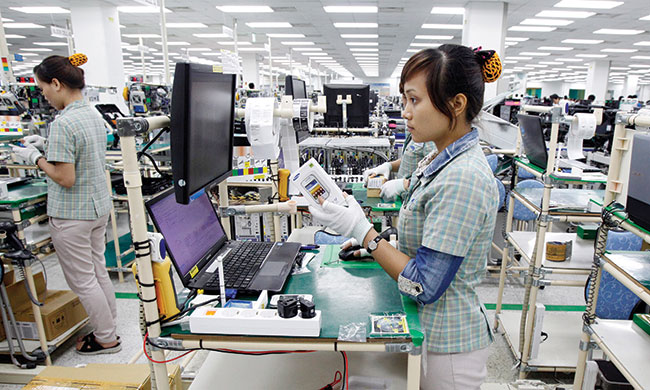Policy opens door to hi-tech investors

The prime ministerial Decision 19/2015/QD-TTg, issued on June 15, 2015 and taking effect from August 1, will substitute for Clause 18 of the Law on High Technology. Under the decision, businesses seeking recognition as a hi-tech firm will first have to be involved in the production of listed hi-tech products and conform to the government’s energy saving and environmental protection standards. The businesses’ average turnover from hi-tech products must be at least 70 per cent of the total annual net revenue.
For small-and medium-sized enterprises (SMEs), they must spend an average of 1 per cent of their total annual net revenue on research and development (R&D) activities in Vietnam. For those with the total equity of over VND100 billion ($4.76 million) and more than 300 labourers, the requirement is at least 0.5 per cent.
In addition, at least 5 per cent of the workforce must have university degrees or higher and be involved in R&D activities, while the rate for those with the total equity of over VND100 billion ($4.76 million) and more than 300 labourers is 2.5 per cent.
“With this new decision, many more hi-tech firms will find easier to meet the criteria. And the changes will surely prompt them to invest more in the field to benefit from incentives,” Dam Bach Duong, head of the High Technology Department under the Ministry of Science and Technology, told VIR.
According to the current regulations, hi-tech enterprises can enjoy a corporate income tax rate of 10 per cent for the first 15 years of operations with profits, as opposed to the normal rate of 22 per cent. Such enterprises can also benefit from a range of other tax breaks.
Previously, Clause 18 of the Law on High Technology stated that both SMEs and big firms could only qualify for incentives as a hi-tech firm if they spent 1 per cent of their total revenue on R&D, and employed 5 per cent of their workforce in this effort.
Industry insiders admitted that the former conditions were major barriers to powerful investors, as even well-known hi-tech firms like Intel, Samsung, and Microsoft failed to meet the criteria.
Together with the relaxed criteria, thanks to cheap labour costs, preferential tax and investment incentives, and its geographically strategic location, Vietnam is fast becoming the go-to-destination for the manufacturing and assembly needs of multinational hi-tech companies.
Germany’s Bosch Vietnam, which sought hi-tech status on several occasions, finally received the recognition in 2014 since its operation started here in 1994. Bosch Vietnam has invested an extra $208 million in the local market to raise the capacity of its factory in the southern province of Dong Nai. The additional capital brings Bosch Vietnam’s total investment in the plant to $340 million.
US-based chipmaker Intel was one of the first hi-tech companies to build a factory in Vietnam. In 2006, the company opened its factory in Ho Chi Minh City with the total registered capital of $300 million, and then increased its investment capital in Vietnam to $1 billion. Intel has announced that it is planning to relocate part of its production facilities in Malaysia and China to Vietnam to cut labour costs.
Meanwhile, Samsung has kicked off its consumer electronics complex worth $1.4 billion at the Saigon Hi-tech Park in Ho Chi Minh City. The Korean giant came to Vietnam with the Samsung Vina Electronics facility in 1996 at the Linh Trung industrial park (IP) in Ho Chi Minh City. The $2.5 billion Samsung Vietnam Electronics complex at the Yen Phong IP in the northern province of Bac Ninh became operational in 2009, while the $5 billion Samsung Vietnam Electronics Thai Nguyen complex at the Yen Binh IP in the northern province of Thai Nguyen went on stream in March 2014.
LG entered the Vietnamese market in 1995 and inaugurated its mega electronics manufacturing complex in the northern port city of Haiphong in March 2015. The South Korean electronics giant plans to invest $1.5 billion in the complex between now and 2028. Recently, LG announced its intention to shift its TV production in Thailand to Vietnam.
Meanwhile, Microsoft’s Nokia manufacturing plant was officially inaugurated in Bac Ninh in October 2013. Microsoft is also in the process of moving 30 smartphone production lines to Vietnam from its four factories in China, Hungary, and Mexico.
What the stars mean:
★ Poor ★ ★ Promising ★★★ Good ★★★★ Very good ★★★★★ Exceptional
Latest News
More News
- Vietnam M&A Forum 2025: new position, new momentum (December 09, 2025 | 14:30)
- FDI in Vietnam jumps on additional capital and share purchases (December 09, 2025 | 13:56)
- VIR gathers dealmakers for M&A forum (December 08, 2025 | 17:17)
- Vietnam steps up green transformation with strong policies and rising investment demand (December 06, 2025 | 12:07)
- Listed companies honoured for information transparency (December 06, 2025 | 11:59)
- CSI 2025 highlights rise of Vietnam’s green champions (December 06, 2025 | 09:00)
- Vietnam strengthens energy storage pathway (December 04, 2025 | 15:05)
- OECD projects moderation in Vietnam’s GDP growth over next two years (December 03, 2025 | 15:22)
- Manufacturing growth holds steady despite storm disruptions (December 02, 2025 | 10:06)
- Sustainable Development Conference 2025 recognises leaders in green growth (November 28, 2025 | 16:18)


















 Mobile Version
Mobile Version